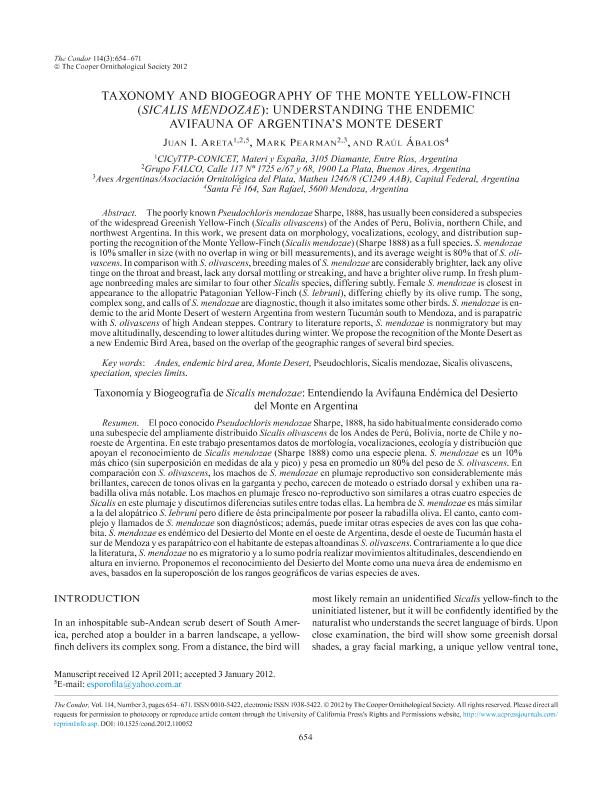Mostrar el registro sencillo del ítem
dc.contributor.author
Areta, Juan Ignacio

dc.contributor.author
Pearman, Mark
dc.contributor.author
Abalos, Raúl Mauro

dc.date.available
2018-07-13T15:39:36Z
dc.date.issued
2012-08
dc.identifier.citation
Areta, Juan Ignacio; Pearman, Mark; Abalos, Raúl Mauro; Taxonomy and biogeography of the Monte Yellow-Finch (Sicalis mendozae): Understanding the endemic avifauna of Argentina's Monte Desert; Cooper Ornithological Society; The Condor; 114; 3; 8-2012; 654-671
dc.identifier.issn
0010-5422
dc.identifier.uri
http://hdl.handle.net/11336/52018
dc.description.abstract
The poorly known Pseudochloris mendozae Sharpe, 1888, has usually been considered a subspecies of the widespread Greenish Yellow-Finch (Sicalis olivascens) of the Andes of Peru, bolivia, northern Chile, and northwest Argentina. In this work, we present data on morphology, vocalizations, ecology, and distribution supporting the recognition of the monte yellow-finch (Sicalis mendozae) (Sharpe 1888) as a full species. S. mendozae is 10% smaller in size (with no overlap in wing or bill measurements), and its average weight is 80% that of S. olivascens. In comparison with S. olivascens, breeding males of S. mendozae are considerably brighter, lack any olive tinge on the throat and breast, lack any dorsal mottling or streaking, and have a brighter olive rump. In fresh plumage nonbreeding males are similar to four other Sicalis species, differing subtly. female S. mendozae is closest in appearance to the allopatric Patagonian yellow-finch (S. lebruni), differing chiefly by its olive rump. The song, complex song, and calls of S. mendozae are diagnostic, though it also imitates some other birds. S. mendozae is endemic to the arid monte Desert of western Argentina from western Tucumán south to mendoza, and is parapatric with S. olivascens of high Andean steppes. Contrary to literature reports, S. mendozae is nonmigratory but may move altitudinally, descending to lower altitudes during winter. we propose the recognition of the monte Desert as a new Endemic bird Area, based on the overlap of the geographic ranges of several bird species. © The Cooper Ornithological Society 2012.
dc.description.abstract
El poco conocido Pseudochloris mendozae Sharpe, 1888, ha sido habitualmente considerado como una subespecie del ampliamente distribuido Sicalis olivascens de los Andes de Perú, Bolivia, norte de Chile y noroeste de Argentina. En este trabajo presentamos datos de morfología, vocalizaciones, ecología y distribución que apoyan el reconocimiento de Sicalis mendozae (Sharpe 1888) como una especie plena. S. mendozae es un 10% más chico (sin superposición en medidas de ala y pico) y pesa en promedio un 80% del peso de S. olivascens. En comparación con S. olivascens, los machos de S. mendozae en plumaje reproductivo son considerablemente más brillantes, carecen de tonos olivas en la garganta y pecho, carecen de moteado o estriado dorsal y exhiben una rabadilla oliva más notable. Los machos en plumaje fresco no-reproductivo son similares a otras cuatro especies de Sicalis en este plumaje y discutimos diferencias sutiles entre todas ellas. La hembra de S. mendozae es más similar a la del alopátrico S. lebruni pero difiere de ésta principalmente por poseer la rabadilla oliva. El canto, canto complejo y llamados de S. mendozae son diagnósticos; además, puede imitar otras especies de aves con las que cohabita. S. mendozae es endémico del Desierto del Monte en el oeste de Argentina, desde el oeste de Tucumán hasta el sur de Mendoza y es parapátrico con el habitante de estepas altoandinas S. olivascens. Contrariamente a lo que dice la literatura, S. mendozae no es migratorio y a lo sumo podría realizar movimientos altitudinales, descendiendo en altura en invierno. Proponemos el reconocimiento del Desierto del Monte como una nueva área de endemismo en aves, basados en la superoposción de los rangos geográficos de varias especies de aves.
dc.format
application/pdf
dc.language.iso
eng
dc.publisher
Cooper Ornithological Society

dc.rights
info:eu-repo/semantics/openAccess
dc.rights.uri
https://creativecommons.org/licenses/by-nc-sa/2.5/ar/
dc.subject
Andes
dc.subject
Endemic Bird Area
dc.subject
Monte Desert
dc.subject
Pseudochloris
dc.subject
Sicalis Mendozae
dc.subject
Sicalis Olivascens
dc.subject
Speciation
dc.subject
Species Limits
dc.subject.classification
Otras Ciencias Biológicas

dc.subject.classification
Ciencias Biológicas

dc.subject.classification
CIENCIAS NATURALES Y EXACTAS

dc.title
Taxonomy and biogeography of the Monte Yellow-Finch (Sicalis mendozae): Understanding the endemic avifauna of Argentina's Monte Desert
dc.title
Taxonomía y Biogeografía de Sicalis mendozae: Entendiendo la Avifauna Endémica del Desierto del Monte en Argentina
dc.type
info:eu-repo/semantics/article
dc.type
info:ar-repo/semantics/artículo
dc.type
info:eu-repo/semantics/publishedVersion
dc.date.updated
2018-07-11T14:09:50Z
dc.journal.volume
114
dc.journal.number
3
dc.journal.pagination
654-671
dc.journal.pais
Estados Unidos

dc.journal.ciudad
Santa Clara
dc.description.fil
Fil: Areta, Juan Ignacio. Provincia de Entre Ríos. Centro de Investigaciones Científicas y Transferencia de Tecnología a la Producción. Universidad Autónoma de Entre Ríos. Centro de Investigaciones Científicas y Transferencia de Tecnología a la Producción. Consejo Nacional de Investigaciones Científicas y Técnicas. Centro Científico Tecnológico Conicet - Santa Fe. Centro de Investigaciones Científicas y Transferencia de Tecnología a la Producción; Argentina. Grupo FALCO; Argentina
dc.description.fil
Fil: Pearman, Mark. Grupo FALCO; Argentina. Asociación Ornitológica del Plata; Argentina
dc.description.fil
Fil: Abalos, Raúl Mauro. No especifica;
dc.journal.title
The Condor

dc.relation.alternativeid
info:eu-repo/semantics/altIdentifier/doi/http://dx.doi.org/10.1525/cond.2012.110052
dc.relation.alternativeid
info:eu-repo/semantics/altIdentifier/url/http://www.bioone.org/doi/abs/10.1525/cond.2012.110052
Archivos asociados
